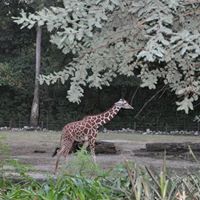Feng Gao
age ~48
from Brooklyn, NY
Feng Gao Phones & Addresses
- 7109 8Th Ave, Brooklyn, NY 11228
- Corona, NY
- Morganville, NJ
Name / Title
Company / Classification
Phones & Addresses
CLEAN CITY LAUNDROMAT NY INC
Coin-Operated Laundry
Coin-Operated Laundry
87-30 Lefferts Blvd, Richmond Hill, NY 11418
8730 Lefferts Blvd, Jamaica, NY 11418
8730 Lefferts Blvd, Jamaica, NY 11418
Principal
International C & D, Inc
Ret Meat/Fish
Ret Meat/Fish
4564 160 St, Flushing, NY 11358
(718)9619009
(718)9619009
Us Patents
-
Determination Of Corticosteroids In Human Plasma Using Micromass Lc/Ms/Ms
view source -
US Patent:6541263, Apr 1, 2003
-
Filed:Feb 21, 2001
-
Appl. No.:09/788353
-
Inventors:Feng Gao - Stamford CT
-
Assignee:Euro-Celtique, S.A. Luxembourg
-
International Classification:G01N 3392
-
US Classification:436 71, 436101, 436173, 436139
-
Abstract:The present invention is directed to a method of detecting a corticosteroid in a sample by adding an internal standard to a sample suspected of containing a corticosteroid; removing interfering compounds from the sample; placing the sample on an HPLC column equilibrated with a NH OAc:MeOH solution and collecting an eluent; and analyzing the eluent of the HPLC column with a MS, wherein if contained in the sample, the corticosteroid forms an adduct that is detected by the MS.
-
Sugar Derivatives Of Hydromorphone, Dihydromorphine And Dihydromorphine, Compositions Thereof And Uses For Treating Or Preventing Pain
view source -
US Patent:6740641, May 25, 2004
-
Filed:Jul 22, 2002
-
Appl. No.:10/199526
-
Inventors:Feng Gao - Stamford CT
Jahanara Miotto - Carmel NY -
Assignee:Euro-Celtique, S.A.
-
International Classification:A01N 4304
-
US Classification:514 27, 514281, 514282, 546 44, 546 45, 546 46, 424 7829
-
Abstract:Glucoside and glucuronide derivatives of hydromorphone, dihydromorphine, and dihydroisomorphine and pharmaceutically acceptable salts thereof; pharmaceutical compositions comprising a glucoside or glucuronide derivative of hydromorphone, dihydromorphine, or dihydroisomorphine or a pharmaceutically acceptable salt thereof; and methods for treating or preventing pain in a patient comprising administering to a patient in need thereof a glucoside or glucuronide derivative of hydromorphone, dihydromorphine, or dihydroisomorphine or a pharmaceutically acceptable salt thereof are disclosed.
-
System And Method For Automatically Detecting A Target Object From A 3D Image
view source -
US Patent:20190050981, Feb 14, 2019
-
Filed:Jun 2, 2018
-
Appl. No.:15/996434
-
Inventors:- Shenzhen, CN
Shanhui Sun - Princeton NJ, US
Hanbo Chen - Seattle WA, US
Junjie Bai - Seattle WA, US
Feng Gao - Seattle WA, US
Youbing Yin - Kenmore WA, US -
Assignee:SHENZHEN KEYA MEDICAL TECHNOLOGY CORPORATION - Shenzhen
-
International Classification:G06T 7/00
G06T 7/11
G06N 3/04
G06N 5/04
G06N 99/00
G06T 11/20
G16H 30/40 -
Abstract:A computer-implemented method for automatically detecting a target object from a 3D image is disclosed. The method may include receiving the 3D image acquired by an imaging device. The method may further include detecting, by a processor, a plurality of bounding boxes as containing the target object using a 3D learning network. The learning network may be trained to generate a plurality of feature maps of varying scales based on the 3D image. The method may also include determining, by the processor, a set of parameters identifying each detected bounding box using the 3D learning network, and locating, by the processor, the target object based on the set of parameters.
-
System And Method For Automatically Detecting A Physiological Condition From A Medical Image Of A Patient
view source -
US Patent:20190050982, Feb 14, 2019
-
Filed:Jul 5, 2018
-
Appl. No.:16/028389
-
Inventors:- Shenzhen, CN
Shanhui Sun - Princeton NJ, US
Feng Gao - Seattle WA, US
Junjie Bai - Seattle WA, US
Hanbo Chen - Seattle WA, US
Youbing Yin - Kenmore WA, US -
Assignee:SHENZHEN KEYA MEDICAL TECHNOLOGY CORPORATION - Shenzhen
-
International Classification:G06T 7/00
G06T 7/70 -
Abstract:The present disclosure is directed to a method and system for automatically detecting a physiological condition from a medical image of a patient. The method may include receiving the medical image acquired by an imaging device. The method may further include detecting, by a processor, target objects and obtaining the corresponding target object patches from the received medical image. And the method may further include determining, by the processor, a first parameter using a first learning network for each target object patch. The first parameter represents the physiological condition level of the corresponding target object, and the first learning network is trained by adding one or more auxiliary classification layers. This method can quickly, accurately, and automatically predict target object level and/or image (patient) level physiological condition from a medical image of a patient by means of a learning network, such as 3D learning network.
Resumes

Feng Gao
view sourceWork:
Dawn Specialty Service, LLC
St. Louis, MO
May 2008 to Dec 2012
Data Administrator eBay Online Business
Oct 2002 to Apr 2008 Harbin Hold computer Company
Harbin, CN
Sep 1999 to Mar 2002
Project Manager and SQL Developer
St. Louis, MO
May 2008 to Dec 2012
Data Administrator eBay Online Business
Oct 2002 to Apr 2008 Harbin Hold computer Company
Harbin, CN
Sep 1999 to Mar 2002
Project Manager and SQL Developer
Education:
Harbin University of Science and Technology
Jun 1999
B.S. in Application Electric Technology
Jun 1999
B.S. in Application Electric Technology
Isbn (Books And Publications)


Zhen Shi De Mao Zedong: Mao Zedong Shen Bian Gong Zuo Ren Yuan De Hui Yi
view sourceAuthor
Feng Gao
ISBN #
7507315479
Flickr
Myspace
Googleplus

Feng Gao
About:
日久見人心 ^^
Bragging Rights:
中華足球奧運培訓隊^^

Feng Gao
Work:
Fujitsu
Sangfor
Sangfor
Education:
NEU - Software college

Feng Gao
Education:
University of California, Berkeley, Sun Yat-sen University
About:
I feel good just to keep my blogs up-to-date.

Feng Gao
Work:
YiLongFeng Tech.Co.,Ltd - President
Education:
University College London

Feng Gao
About:
糕盼的平方

Feng Gao
Education:
Peking University

Feng Gao
Education:
University College of Gävle

Feng Gao
About:
中指劳损者
News

NIH-halted study unveils its massive analysis of bat coronaviruses
view source- Duke Universitys Feng Gao, who led an analysis published on 29 May in Science about the evolution of SARS-CoV-2, says the new work by Daszak, Shi, and colleagues underscores that researchers have just sampled the tip of the iceberg of the coronaviruses circulating between bats that could jump int
- Date: Jun 01, 2020
- Category: Health
- Source: Google

Evolution of pandemic coronavirus outlines path from animals to humans
view source- "Very much like the original SARS that jumped from bats to civets, or MERS that went from bats to dromedary camels, and then to humans, the progenitor of this pandemic coronavirus underwent evolutionary changes in its genetic material that enabled it to eventually infect humans," said Feng Gao, M.D.
- Date: May 29, 2020
- Category: Health
- Source: Google
Youtube

Feng Gao
view source
Feng Gao
view source
Xiao Feng Gao
view source
Feng Gao
view source
Feng Gao
view source
Feng Gao
view source
Feng Gao Hg
view source
Feng Gao
view sourcePlaxo

Feng Gao
view sourceFeng 素質
Classmates

Feng Gao
view sourceSchools:
Jinan University Guangzhou China 1967-1971

Feng Gao
view sourceSchools:
Windsor School Flushing NY 2001-2005
Community:
Bruce Eder, Jean Sobolow, Linda Comac, David Federbush

Feng Gao, Hopi High Schoo...
view source
Jinan University, Guangzhou
view sourceGraduates:
Feng Gao (1967-1971),
Mumian Gao (1983-1987),
Zhuoying Peng (1992-1996),
Chau Chuen Yan (1994-1998)
Mumian Gao (1983-1987),
Zhuoying Peng (1992-1996),
Chau Chuen Yan (1994-1998)

Hopi High School, Keams c...
view sourceGraduates:
Feng Gao (1993-1997),
Dorcia Chee (1995-1999),
Collin Campus (1996-2000),
Ema Mae Thompson (2003-2007),
Alysia Kewanyama (2006-2010)
Dorcia Chee (1995-1999),
Collin Campus (1996-2000),
Ema Mae Thompson (2003-2007),
Alysia Kewanyama (2006-2010)

Windsor School, Flushing,...
view sourceGraduates:
Marleyne Massen (1969-1973),
Allen Alvir (1991-1995),
Feng Gao (2001-2005),
Anthony Valentino (1979-1983)
Allen Alvir (1991-1995),
Feng Gao (2001-2005),
Anthony Valentino (1979-1983)

Hartford Central School, ...
view sourceGraduates:
Gao Feng (1996-2000),
Brandi Andrews (1986-1990),
April Jordan (1990-1993),
David Harringotn (1970-1978)
Brandi Andrews (1986-1990),
April Jordan (1990-1993),
David Harringotn (1970-1978)
Get Report for Feng Gao from Brooklyn, NY, age ~48












![(Rang Feng Gao Su Ni) [Let The Wind Tell You] - Ge... (Rang Feng Gao Su Ni) [Let The Wind Tell You] - Ge...](https://i.ytimg.com/vi/Bb0pN30qoyU/hqdefault.jpg?sqp=-oaymwE2COADEI4CSFXyq4qpAygIARUAAIhCGAFwAcABBvABAfgB_gmAAtAFigIMCAAQARgPIGQoZTAP&rs=AOn4CLBB0nWsQ-2jNqcXa2kIG2cJDf7URw)

